Papers by Charles B Chisanga
Field Crops Research, Oct 1, 2023

Geographic Information System [Working Title]
The Markov, Cell Atom and CA-Markov modules in TerrSet v19.0 have been applied to predict LULC ma... more The Markov, Cell Atom and CA-Markov modules in TerrSet v19.0 have been applied to predict LULC maps for 2030 over Zambia. The European Space Agency Climate Change Initiative (ESA CCI) classified LULC maps for 2000, 2010 and 2020 were used in this study. The ESA-CCI LULC maps were reclassified using QGIS 3.20 into 10 classes. The 2000 and 2010 LULC maps were used to predict the 2020 LULC maps. The Kappa statistics between the 2020 reference and predicted LULC maps was kappa (0.9918). The probability and transition matrix between the 2010 and 2020 LULC maps were used as inputs into the CA-Markov module to generate the 2030 LULC map. The LULCC from 2020-2030 shows an expansion and contraction of different classes. However, Built-up (42.38% [481.82 km2]) constitutes major changes among the LULC classes. However, Cropland, Dense forest, Grassland, Wetland and Bare land will reduce by 376.00, 1087.65, 70.60, 26.67 and 0.36 km2, respectively. Other LULC changes from 2020-2030 are in season...
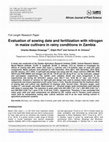
African Journal of Plant Science, 2019
A study was conducted at the Zambia Agriculture Research Institute (ZARI), Central Research Stati... more A study was conducted at the Zambia Agriculture Research Institute (ZARI), Central Research Station, Mount Makulu (latitude: 15.550° S, longitude: 28.250° E, altitude: 1213 m), Zambia to investigate the effects of sowing date (SD), maize (Zea mays L.) cultivars and 3 N fertilizer rates on yield and yield components. Maize cultivars were planted on 12th December, 2016 (SD1), 26th December, 2016 (SD2) and 9th January, 2017 (SD3). A split-split plot design was setup with SD, maize cultivars (ZMS 606, PHB 30G19 and PHB 30B50) and nitrogen rate (67.20, 134.40 and 201.60 kg N ha-1) as the main-plot, subplot and sub-subplot, respectively. The rainfall, solar radiation (Srad) and mean temperature at the experimental site during the 2016/2017 season were 930.17 mm, 18.93 MJ m-2 day-1 and 21.83°C, respectively. Analysis of variance for Split-split plot design was used to analyze maize yield and yield components and means separated at p≤5 using Tukey's Tests. Results showed that the treatment effect of sowing date and cultivar was significant on biomass yield, harvest index, 100-grain weight, seed number m-2 , cob length, and width. Seed number m-2 , 100-grain weight, grain and biomass yield reduced with delay in sowing date. The reduction in grain yield from SD1-SD2 (1.91 t ha-1), SD1-SD3 (2.90 t ha-1) and SD2-SD3 (0.99 t ha-1) were 21.04, 31.83 and 13.83%, respectively. Therefore, it was concluded that maize grain yield and yield components are affected by SD, cultivar and N. Farmers could enhance maize yield by manipulating sowing date, cultivar selection and N as the most limiting nutrient in agriculture production systems.
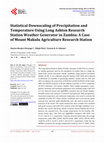
American Journal of Climate Change, 2017
The Long Ashton Research Station Weather Generator (LARS-WG) is a stochastic weather generator us... more The Long Ashton Research Station Weather Generator (LARS-WG) is a stochastic weather generator used for the simulation of weather data at a single site under both current and future climate conditions using General Circulation Models (GCM). It was calibrated using the baseline (1981-2010) and evaluated to determine its suitability in generating synthetic weather data for 2020 and 2055 according to the projections of HadCM3 and BCCR-BCM2 GCMs under SRB1 and SRA1B scenarios at Mount Makulu (Latitude: 15.550˚S, Longitude: 28.250˚E, Elevation: 1213 meter), Zambia. Three weather parameters-precipitation, minimum and maximum temperature were simulated using LARS-WG v5.5 for observed station and AgMERRA reanalysis data for Mount Makulu. Monthly means and variances of observed and generated daily precipitation, maximum temperature and minimum temperature were used to evaluate the suitability of LARS-WG. Other climatic conditions such as wet and dry spells, seasonal frost and heat spells distributions were also used to assess the performance of the model. The results showed that these variables were modeled with good accuracy and LARS-WG could be used with high confidence to reproduce the current and future climate scenarios. Mount Makulu did not experience any seasonal frost. The average temperatures for the baseline (Observed station data:

Journal of Geography and Geology
This study was conducted within the Zambezi River Basin to ascertain the bathymetry and sedimenta... more This study was conducted within the Zambezi River Basin to ascertain the bathymetry and sedimentation of selected reservoirs, evaluate their seasonal hydrological regimes, pinpoint the causes of reservoir siltation, and determine how the bathymetry and siltation impacted water-related industries and policy choices. Hydrological field measurements using a hydrographic survey boat, document studies, and interviews were used to collect the data. The 3D spatial analyst tools in ArcGIS 10.3 and hypsometric curves were used to analyze bathymetric data. Thematic analysis was used to analyze qualitative interview data. Findings indicated that sedimentation was a problematic phenomenon spatial-temporally and, it triggered a significant decrease in the storage capacities of the reservoirs. The study noted that catchments with small reservoirs were vulnerable to severe water stress, particularly from July through the beginning of the next rainy season in December. Over 90% of the local populat...
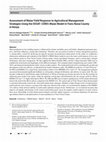
International Journal of Plant Production
Maize production in low-yielding regions is influenced by climate variability, poor soil fertilit... more Maize production in low-yielding regions is influenced by climate variability, poor soil fertility, suboptimal agronomic practices, and biotic influences, among other limitations. Therefore, the assessment of yields to various management practices is, among others, critical for advancing site-specific measures for production enhancement. In this study, we conducted a multiseason calibration and evaluation of the DSSAT–CERES-Maize model to assess the maize yield response of two common cultivars grown in Trans Nzoia County in Kenya under various agricultural strategies, such as sowing dates, nitrogen fertilization, and water management. We then applied the Mann–Kendall (MK), and Sen’s Slope Estimator (SSE) tests to establish the yield trends and magnitudes of the different strategies. The evaluated model simulated long-term yields (1984–2021) and characterized production under various weather regimes. The model performed well in simulating the growth and development of the two cultiva...

CAB Reviews: Perspectives in Agriculture, Veterinary Science, Nutrition and Natural Resources, 2022
Numerous modelling efforts have focused on maize as it is an important cereal crop for both human... more Numerous modelling efforts have focused on maize as it is an important cereal crop for both human consumption and livestock production. Crop simulation and multi-linear regressions models can be used to quantify the likely potential impacts of climate change on maize growth and yield. Such models include AquaCrop, Agricultural Production Systems Simulator (APSIM), Decision Support System for Agro-technology Transfer (DSSAT), EPIC, CropSyst, Root Zone Water Quality Model (RZWQM2), SARRA-H, IMPACT+DSSAT, DSSAT, ALAMANC, WOFOST, ADEL, GEPIC, Empirical, MOS, GLAM-Maize, InfoCrop and EcoCrop, among others. Models give predictions utilizing meteorological, soil and crop data in numerical simulations. Various sources of climatic data are available including government meteorological and research departments, world organizations and private institutions. Climate data can also be generated using statistical and dynamical downscaling tools. The review showed that future maize growth and yield...
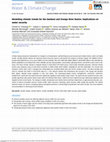
Journal of Water and Climate Change, 2022
Climate change impacts are dependent on changes in air temperature, rainfall (frequency and amoun... more Climate change impacts are dependent on changes in air temperature, rainfall (frequency and amount) and climate indices, which are highly certain. Climate extreme indices are important metrics that are used to communicate the impacts of climate change. The CORDEX African-domain RCM (SMHI-RCA4) run by seven CMIP5 (CCCma-CanESM2, IPSL-IPSL-CM5A-MR, MIROC-MIROC5, MPI-M-MPI-ESM-LR, NCC-NorESM1-M, MOHC-HadGEM2-ES and NOAA-GFDL-GFDL-ESM2M) and two representative concentration pathways (RCP4.5 and RCP8.5) were used in this study. The future climate change is analysed relative to 2020–2050/1970–2000 using a multi-model ensemble projection. Selected climate indices were analysed using a multi-model ensemble of CMIP5 GCMs (GFDL-ESM2G, HadGEM2-ES and IPSL-CM5A-MR). The climate data operators (CDOs) were used in merging and manipulating the modelled (RCM) data and ETCCDI climate indices. The Mann–Kendall was used to compute the trends in time-series data at p < 0.05. Results indicate that te...
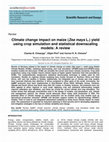
Scientific Research and Essays, 2017
Review of literature related to the impact of climate change on maize (Zea mays L.) yield using G... more Review of literature related to the impact of climate change on maize (Zea mays L.) yield using Global Climate Models (GCMs), statistical downscaling, and crop simulation (APSIM-maize-and-CERES-maize models) models are discussed. GCMs can simulate the current and future climatic scenarios. Crop yield projections using crop models require climate inputs at higher spatial resolution than that provided by GCMs. The computationally inexpensive statistical downscaling technique is widely used for this translation. Studies on regional climate modeling have mostly focused on Southern Africa and West Africa, with very few studies in Zambia. Additionally, the integrated use of climate and crop models have received relatively less attention in Africa compared to other parts of the world. Conversely, the AgMIP protocols have been implemented in Sub-Saharan Africa (SSA) (Ethiopia, Kenya, Tanzania, Uganda and South Africa) and South Asia (SA) (Sri Lanka). In Zambia, however, the protocols have not been applied at either regional or local scale. Applying crop and statistical downscaling models requires calibration and validation, and these are crucial for correct climate and crop simulation. The review shows that although uncertainties exist in the design of models, and parameters, soil, climate and management options, the climate would adversely affect maize yield production in SSA. The potential effect of climate change on maize production can be studied using crop models such as agricultural production simulator (APSIM) and decision support system for agrotechnology (DSSAT) models. There is need to use integrated assessment modeling to study future climate impact on maize yield. The assessment is essential for long-term planning in food security and in developing adaptation and mitigation strategies in the face of climate variability and change.
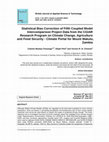
British Journal of Applied Science & Technology, 2017
Although Global Climate Models (GCMs) are regarded as the best tools available for future climate... more Although Global Climate Models (GCMs) are regarded as the best tools available for future climate projections, there are biases in simulating precipitation and temperature due to their coarse spatial resolution and cannot be used directly to assess the impact of projected climate change. The study objective was to investigate how bias correction methods impact the modelled future climate change under Representative Concentration Pathway 8.5 (RCP8.5) for 2020-2050.Reanalysisdata (1980-2000) and bias correction approaches (change factor [CF], nudging and Quantile Mapping [QM]) were used to calibrate GCMs [GFDL-ESM2M, MIROC-MIROC5, MPI-ESM-MR, and NCAR-CCSM4] data under RCP8.5 scenarios (2020-2050) for Mount Makulu, Zambia (latitude: 15.550° S, longitude: 28.250° E, altitude: 1200 m). Bias correcti on methods enable the comparison of observed Original Research Article
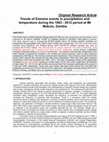
Journal of Scientific Research and Reports, 2017
The Expert Team on Sector-specific Climate Indices (ET-SCI) for daily temperature and precipitati... more The Expert Team on Sector-specific Climate Indices (ET-SCI) for daily temperature and precipitation were analyzed for Mt Makulu (Latitude: 15.550 o S, Longitude: 28.250 o E, Elevation: 1200 meter) in Zambia. The study objective was to evaluate the ET-SCI climate indices for extreme weather conditions on temperature and precipitation from 1963 to 2012. Quality and homogeneity of the time series data were checked using RHtestsV4 and RHtests_dlyPrcp while ClimPACT2 software package was used to compute the ET-SCI indices. The Mann-Kendall for annual maximum and mean temperature were statistically significant with a positive linear trend (p<0.05). Additionally, results showed a significant increase in absolute indices as a function of temperature. The maximum warmest daily temperature (TXx) index showed a predominant increase in the monthly and annual maximum value of daily maximum temperature at Mt Makulu. The minimum warmest daily temperature (TXn) showed a similar trend for the annual value. Results also showed that the daily mean temperature (TMm) and mean daily maximum temperature (TXm) had increased from 1963-2012. The Daily Temperature Range (DTR) significantly increased annually and monthly resulting in a linear slope of 0.031 and 0.003, respectively. SU (Number of days when TX > 25 °C) for both monthly and annual trend had increased significantly with a slope of 1.204 and 0.009, respectively. There were much higher heat spell events during DJF and SON with probability occurrence of 0.78 and 0.98 at p<0.05, respectively. Precipitation extreme indices (PRCPTOT, R30mm, RX5day, and R95p) had a non-significant positive trend at p<0.05.
Hydrological Sciences Journal, 2010
1991 National Winter Cereal Seminar, Tak ( …, 1991
Go to AGRIS search. Effect of planting date and nitrogen application on barley quality. Lamaimaat... more Go to AGRIS search. Effect of planting date and nitrogen application on barley quality. Lamaimaat Khowchaimaha (Phrae Rice Research Center, Phrae (Thailand)). Record number, TH9620793. Conference, 1991 National Winter Cereal Seminar, Tak (Thailand), 7-9 Aug 1991. ...
… Resource Management & …, 2000
... Next to the development of new management strategies to supply fresh water, the issue of trea... more ... Next to the development of new management strategies to supply fresh water, the issue of treating and recycling wastewater will play an important role in tackling the existing and occurring problems. ... Kretschmer, N.; Ribbe, L. und Gaese, H.: Wastewater Reuse for Agriculture ...
Journal of Agricultural Science, 2015
A field experiment was conducted during the 2013/2014 season to evaluate the performance of CERES... more A field experiment was conducted during the 2013/2014 season to evaluate the performance of CERES-maize model in simulating the effect of date of planting, nitrogen fertilizer and root-zone soil water profile on growth and yield of maize (Zea mays L.
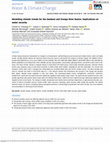
Climate change impacts are dependent on changes in air temperature, rainfall (frequency and amoun... more Climate change impacts are dependent on changes in air temperature, rainfall (frequency and amount) and climate indices, which are highly certain. Climate extreme indices are important metrics that are used to communicate the impacts of climate change. The CORDEX Africandomain RCM (SMHI-RCA4) run by seven CMIP5 (CCCma-CanESM2, IPSL-IPSL-CM5A-MR, MIROC-MIROC5, MPI-M-MPI-ESM-LR, NCC-NorESM1-M, MOHC-HadGEM2-ES and NOAA-GFDL-GFDL-ESM2M) and two representative concentration pathways (RCP4.5 and RCP8.5) were used in this study. The future climate change is analysed relative to 2020-2050/1970-2000 using a multi-model ensemble projection. Selected climate indices were analysed using a multi-model ensemble of CMIP5 GCMs (GFDL-ESM2G, HadGEM2-ES and IPSL-CM5A-MR). The climate data operators (CDOs) were used in merging and manipulating the modelled (RCM) data and ETCCDI climate indices. The Mann-Kendall was used to compute the trends in time-series data at p , 0.05. Results indicate that temperature will increase in the Orange and Zambezi River Basins. Rainfall shows variability in both river basins. The temperature-based indices (tn90pETCCDI, tnnETCCDI, tnxETCCDI, tx90pETCCDI, txnETCCDI and txxETCCDI) were statistically significant with positive linear trends. The dtrETCCDI and wsdiETCCDI were statistically significant with positive linear trends within the Zambezi River Basin. csdiETCCDI and tn10pETCCDI were statistically significant with negative trends in both basins. The change in rainfall, temperature and climate indices will have implications on agricultural production, provisions of various ecosystem services, human health, water resources, hydrology, water security, water quality and quantity. The climate extreme indices can assist in analysing regional and global extremes in meteorological parameters and assist climate, and crop modellers and policymakers in assessing sectoral impacts.
CABI Reviews, 2022
Numerous modelling efforts have focused on maize as it is an important cereal crop for both human... more Numerous modelling efforts have focused on maize as it is an important cereal crop for both human consumption and livestock production. Crop simulation and multi-linear regressions models can be used to quantify the likely potential impacts of climate change on maize growth and yield.

Uploads
Papers by Charles B Chisanga